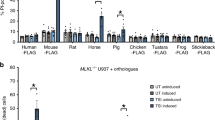Abstract
THE effector arm of the cell-death pathway is composed of cysteine proteases belonging to the ICE/CED-3 family1,2. In metazoan cells these exist as inactive polypeptide precursors (zymogens), each composed of a prodomain, which is cleaved to activate the protease, and a large and small catalytic subunit. The coupling of these 'death' proteases to signalling pathways is probably mediated by adaptor molecules that contain protein–protein interaction motifs such as the death domain1. Here we describe such an adaptor molecule, RAIDD, which has an unusual bipartite architecture comprising a carboxy-terminal death domain that binds to the homologous domain in RIP, a serine/threonine kinase component of the death pathway3,4. The amino-terminal domain is surprisingly homologous with the sequence of the prodomain of two ICE/CED-3 family members, human ICH-1 (ref. 5) and Caenorhabditis elegans CED-3 (ref. 6). This similar region mediates the binding of RAIDD to ICH-1 and CED-3, serving as a direct link to the death proteases, indicating that the prodomain may, through homophilic interactions, determine the specificity of binding of ICE/CED-3 zymogens to regulatory adaptor molecules. Finally, alternations in the sequence of the N-terminal domain that are equivalent to inactivating mutations in the C. elegans ced-3 gene7,8 prevent homophilic binding, highlighting the potentially primordial nature of this interaction.
This is a preview of subscription content, access via your institution
Access options
Subscribe to this journal
Receive 51 print issues and online access
$199.00 per year
only $3.90 per issue
Buy this article
- Purchase on Springer Link
- Instant access to full article PDF
Prices may be subject to local taxes which are calculated during checkout
Similar content being viewed by others
References
Fraser, A. & Evan, G. Cell 85, 781–784 (1996).
Henkart, P. Immunity 4,195–201 (1996).
Stanger, B. Z., Leder, P., Lee, T. H., Kim, E. & Seed, B. Cell 81, 513–523 (1995).
Hsu, H., Huang, J., Shu, H.-B., Baichwal, V. & Goeddel, D. V. Immunity 4, 387–396 (1996).
Wang, L., Miura, M., Bergeron, L., Zhu, H. & Yuan, J. Cell 78, 739–750 (1994).
Yuan, J., Shaham, S., Ledoux, S., Ellis, H. M. & Horvitz, H. R. Cell 75, 641–652 (1993).
Ellis, H. M. & Horvitz, H. R. Cell 44, 817–829 (1986).
Shaham, S. & Horvitz, H. R. Genes Dev. 10, 578–591 (1996).
Cleveland, J. L. & Ihle, J. N. Cell 81, 479–482 (1995).
Lennon, G., Auffray, C., Polymeropoulos, M. & Soares, M. B. Genomics 33,151–152 (1996).
Sambrook, J., Fritsch, E. F. & Maniatis, T. Molecular Cloning: A Laboratory Manual 2nd edn (Cold Spring Harbor Laboratory Press, New York, 1989).
Chinnaiyan, A. M., O'Rourke, K., Tewari, M. & Dixit, V. M. Cell 81, 505–512 (1995).
Higuchi, R., Krummel, B. & Saiki, R. K. Nucleic Acids Res. 16, 7351–7367 (1988).
Muzio, M. et al. Cell 85, 817–827 (1996).
O'Rourke, K. M., Laherty, C. D. & Dixit, V. M. J. Biol. Chem. 267, 24921–24924 (1992).
Tewari, M. & Dixit, V. M. J. Biol. Chem. 270, 3255–3260 (1995).
Author information
Authors and Affiliations
Rights and permissions
About this article
Cite this article
Duan, H., Dixit, V. RAIDD is a new 'death' adaptor molecule. Nature 385, 86–89 (1997). https://doi.org/10.1038/385086a0
Received:
Accepted:
Issue Date:
DOI: https://doi.org/10.1038/385086a0
This article is cited by
-
The p53-caspase-2 axis in the cell cycle and DNA damage response
Experimental & Molecular Medicine (2021)
-
Uncovering the PIDDosome and caspase-2 as regulators of organogenesis and cellular differentiation
Cell Death & Differentiation (2020)
-
Pigment epithelium-derived factor mediates retinal ganglion cell neuroprotection by suppression of caspase-2
Cell Death & Disease (2019)
-
Interview: a conversation with Vishva M Dixit on his journey from remote African village to apoptosis, necroptosis and the inflammasome
Cell Death & Differentiation (2019)
-
Caspases in retinal ganglion cell death and axon regeneration
Cell Death Discovery (2017)
Comments
By submitting a comment you agree to abide by our Terms and Community Guidelines. If you find something abusive or that does not comply with our terms or guidelines please flag it as inappropriate.



